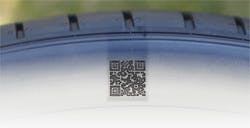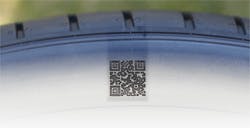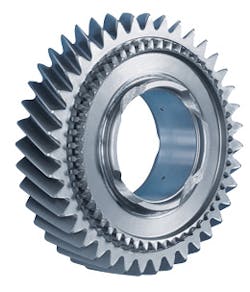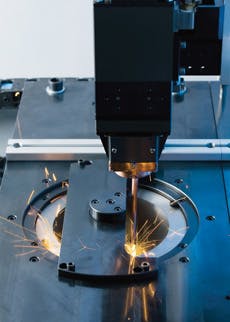Laser markings readable with smartphone apps
Alsdorf, Germany -- A solution to individually mark every tire with a unique and permanent QR (quick response) code that can be identified with most smartphone camera apps was recently introduced at an industry trade show in Cologne.
4JET Technologies GmbH (www.scannection.de), a company that specializes in laser systems for processing of delicate technical surfaces, has developed a novel laser marking process that can engrave an individual datamatrix code in tire sidewalls. The high contrast engraving can be read using public domain apps available for Apple OS or Android devices.
The SCANNECT solution--— short for "scan and connect"--— enables a long-standing wish of the tire industry: being able to trace tires through their life cycle and thus keep in closer touch with its end customers.
Unlike machine-readable paper barcodes that have a limited lifetime, or molded quick-response (QR) codes that are not unique, or RFID tags that require specific reading hardware, or engraved plain text serial codes that require typing in numbers offline, this solution enables a one-of-a-kind product identifier that can directly link to a web-based customer-relationship-management (CRM) database.
Such a direct link provides advantages for all stages of the tire value chain:
- Manufacturers can get to know their end customers and address them with specific marketing campaigns, such as warranty extensions; winter tire promotions; and social media campaigns.
- Original-equipment (OE) car-tire manufacturers can employ
QR codes as a means of assuring traceability and reducing the impact of product recalls.
- Commercial fleet managers can use laser markings to organize inventory, track usage, and prevent theft.
- End customers can retrieve valuable technical and commercial information about their tire specs, find suitable replacements, or enter online marketplaces to replace or sell used tires.
The crisp laser markings are either applied in the tire factory, further downstream in the car/wheel assembly, or at the point of sale. Laser-engraved QR codes are recessed into the surface of the tire and hence protected from wear.
Marking is performed by the latest version of the company's T-Mark systems that are widely used in new tire and retread tire manufacturing worldwide. Compared to conventional laser marking, which only leaves a low contrast mark on the black tire surface, the SCANNECT process creates a deep black marking on the bottom of the engraving, providing enough contrast to be read with cameras in mobile devices. The proprietary process, comprising special optics, laser parameters, and control software integrated in the company's standard marking systems, is now commercially available.
The Optronics and Glass segment at 4Jet develops micromachining systems for patterning and modification of thin films in photovoltaics and display technology, as well as laser solutions for separation of glass.
For more information, contact 4Jet Technologies at [email protected].
Laser welding transmission components
Farmington Hills, MI– For a transmission component, a small wheel with an integrated synchronous gear represents a relatively complex design to manufacture efficiently and at the highest precision, where two different parts are produced separately and subsequently joined in a welding and joining process.
"It is at this point in modern transmission manufacture that laser welding comes into play," explains Dr. Andreas Mootz, managing director of EMAG Automation (www.emag.com). "The process allows manufacturers to concentrate a carefully dosed amount of the energy emitted by a laser beam on the welding point, minimizing possible warping yet still achieving high welding speeds." The EMAG welding process uses solid-state lasers with an outstanding efficiency factor of ~20 percent, says Mootz. Noticeably less power is used to achieve the same optical performance with solid-state lasers, massively reducing energy costs in production.
Single setup welding
Production sequences are fully integrated on the company's ELC welding system, beginning with a work spindle that uses the pick-up principle to load itself. Components are then clamped and pressed together in the joining press to insure highly accurate positioning of the components, providing ideal conditions for the welding process. Depending on workpiece or material, the components can be induction-preheated prior to the welding process and brushed thereafter. Regardless of what is required, the process is completed in a single setup. The complete joining and welding process for a gearwheel takes just 12 s, while the components for a differential are finish-welded within 40 s.
Laser welding advances construction
For some time now, automotive companies have been replacing the screw-type connection between the differential housing and crown gear with a welding seam, resulting in a reduced material cost while the weight of the assembly falls by approximately 1.2 kg. "These kinds of savings are a significant advancement in lightweight construction within the automotive industry," says Mootz.
With over 50 systems sold to all the leading automobile manufacturers, EMAG is a leader in solid-state laser systems for the production of transmission and powertrain components. "That we have a large reservoir of know-how in the manufacture of these components at our disposal is essential. We know the whole manufacturing process, from turning and grinding to welding and the concluding ultrasound testing process," says Mootz. "We can develop and construct the complete process. This massively simplifies the planning of new production sites and the expansion of existing ones."
It is not only the successful dual-clutch transmission that creates the increasing demand for gears. Conventional transmission systems also tend to have more speed gears, as this reduces fuel consumption and improves the driving comfort.
For more information on this application, contact: [email protected].



